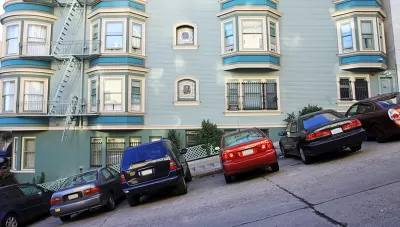Something strange is taking place in the City by the Bay. It's not just experiencing a growth in carless households—carless households are actually replacing those with cars.

We've read that driving has been declining and that Americans are owning fewer cars, particularly among Millennials in major urban centers. Nowhere in the U.S. may this be more true than in San Francisco.
"Between 2000 and 2012, the city has seen a net increase of 11,139 households, and 88 percent of them have been car-free. That’s according to an analysis of U.S. Census data by Michael Rhodes, a transportation planner at Nelson\Nygaard and a former Streetsblog reporter," writes Aaron Bialick, editor of Streetsblog San Francisco.
This is not the result of an increase in housing without parking, though at least one, 12-unit apartment building planned without parking has been proposed in the Mission District as we noted two years ago (based on an article by Bialick). Rather, it's evidence that building housing without parking will attract households without cars.
The increase in carless households also results from existing households shedding cars, perhaps made possible by "expanded bike lanes, car-share services, and improved taxi service (besides the new 'ride-share' apps like Uber and Lyft)," according to Livable City Executive Director Tom Radulovich. He also notes that "Muni, BART, and Caltrain ridership have also increased to record levels over the years."
And then there are the notorious tech buses and shuttles (that many San Franciscans love to blame for the city's gentrification) that enable car-free living.
The next change will hopefully be in the city's planning department, if they greenlight carless housing.
FULL STORY: Car-Free Households Are Booming in San Francisco

Manufactured Crisis: Losing the Nation’s Largest Source of Unsubsidized Affordable Housing
Manufactured housing communities have long been an affordable housing option for millions of people living in the U.S., but that affordability is disappearing rapidly. How did we get here?

Americans May Be Stuck — But Why?
Americans are moving a lot less than they once did, and that is a problem. While Yoni Applebaum, in his highly-publicized article Stuck, gets the reasons badly wrong, it's still important to ask: why are we moving so much less than before?

Research Shows More Roads = More Driving
A national study shows, once again, that increasing road supply induces additional vehicle travel, particularly over the long run.

Pittsburgh Rolls Out Electric School Buses
Pittsburgh Public Schools has launched its first electric school buses, with plans to fully electrify its fleet over the next 14 months, aiming to create a cleaner, more sustainable transportation system supported by new charging infrastructure.

Concrete to Community: A Schoolyard Makeover in West Philly
With guidance from the Trust for Public Land, third graders at Overbrook Elementary are leading the redesign of their asphalt schoolyard into a vibrant green space, learning valuable skills and creating lasting community impact in the process.

Which US Rail Agencies Are Buying Zero-Emissions Trains?
U.S. rail agencies are slowly making the shift to zero-emissions trains, which can travel longer distances without refueling and reduce air pollution.
Urban Design for Planners 1: Software Tools
This six-course series explores essential urban design concepts using open source software and equips planners with the tools they need to participate fully in the urban design process.
Planning for Universal Design
Learn the tools for implementing Universal Design in planning regulations.
City of Moreno Valley
Institute for Housing and Urban Development Studies (IHS)
City of Grandview
Harvard GSD Executive Education
NYU Wagner Graduate School of Public Service
City of Cambridge, Maryland
Newport County Development Council: Connect Greater Newport



























